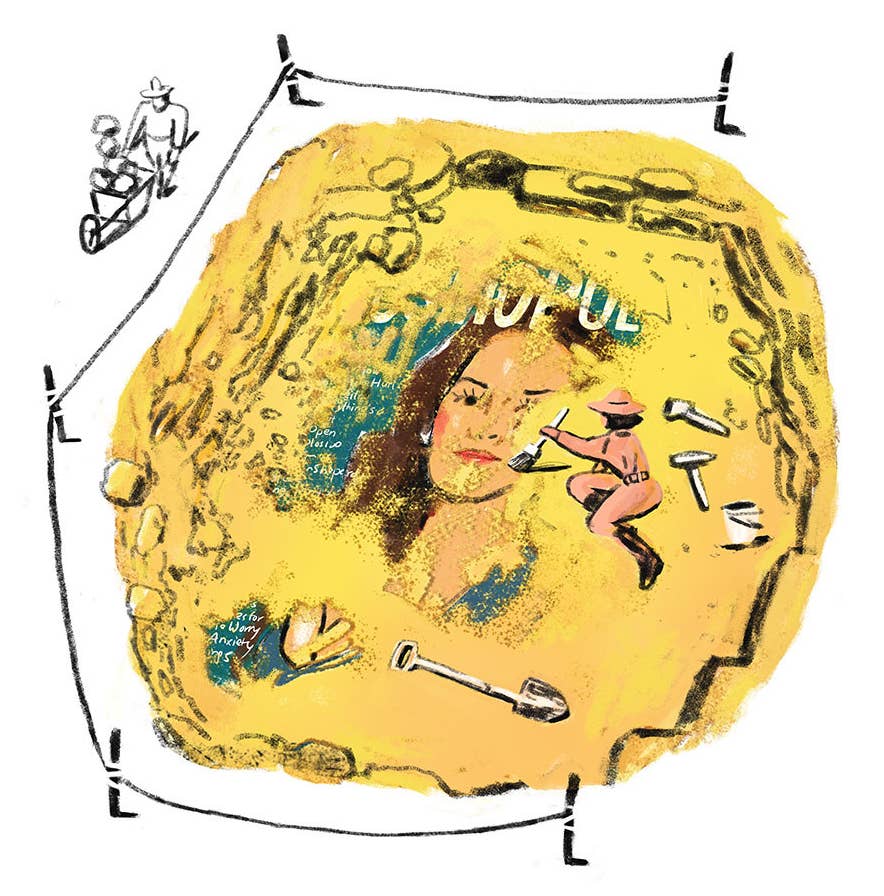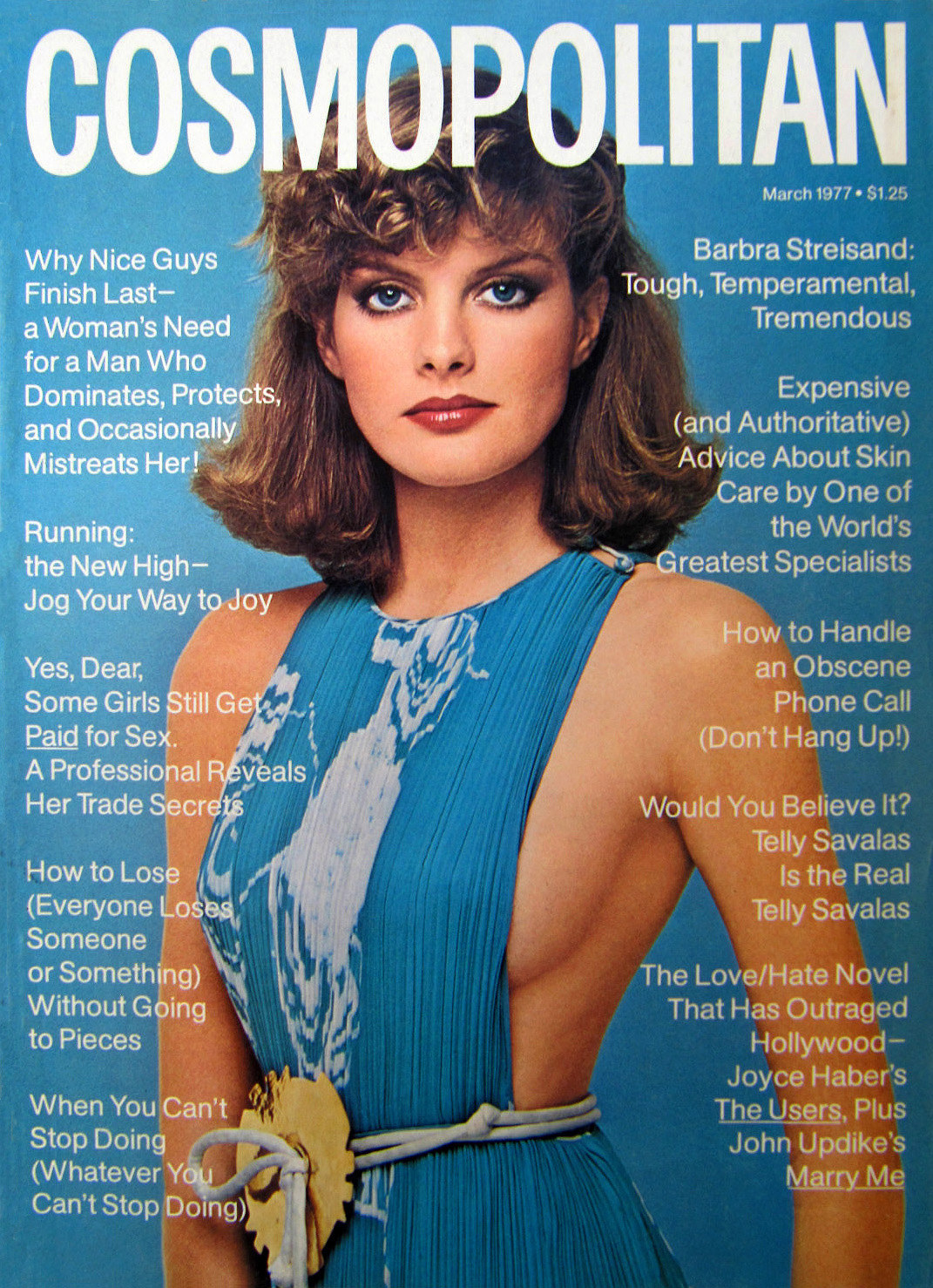Area of Expertise is a column on niche interests, personal passions, and other things we might know or care a little too much about.

Rene Russo wears a vertiginously cut blue dress and stands in front of a matching blue backdrop, her expression serious and smoldering. She is flanked by text — headlines about dominant men, sex work, Barbra Streisand, obscene phone calls, Telly Savalas, and John Updike.
It’s March of 1977, and this is the cover of Cosmopolitan magazine, the publication that, for decades, has been a standard-bearer of commercialized sexual liberation for the modern woman. For a few years now, these covers have been a source of fascination for me. Current Cosmopolitan covers, invariably featuring pop stars and infinite variations on “wild” sex tips, aren’t especially exciting. But the covers of the 1970s — published relatively early on in the 32-year tenure of legendary Cosmo editor Helen Gurley Brown — have a particular mystique.
There’s a certain formula here, one that relies on the simple pleasures of a well-dressed babe: Each cover features a glamorous model wearing a sexy outfit and vamping in front of a perfectly coordinated solid-colored backdrop, flanked by dense columns of headlines written in plain white text. And to me, the consistent look of these covers — photographed and styled by Francesco Scavullo, whose aesthetic was so distinct it became known in the fashion world as “Scavullo-ization” — is strangely comforting. A Google Image search reveals a pleasing rainbow spectrum of fabulously attired, confident women.
In the ‘70s, the women’s liberation movement was becoming part of the national consciousness and feminism started to find its way into popular culture. And Cosmopolitan covers are a perfect document of that historical moment. “Change Your Life Learning How to Assert Yourself Instead of Being Pushed Around,” promises the March 1976 cover, featuring model Denise Hopkins in a mint green, disco-ready dress.
Further down, below headlines about weight loss and Merv Griffin, is “When You Should Give Up Your Husband for a Lover.” Years before the jargon of Sheryl Sandberg’s Lean In, #GirlBoss, and the social media onslaught of sex positivity, Cosmopolitan was filling out its covers with messages of confidence and a distinct lack of slut-shaming. Having an overtly sexy woman on the cover of a magazine that’s meant for a female audience reinforced the complicated, sometimes contradictory message that Gurley Brown founded her career on: that feminism and traditional femininity need not be at odds. While such an idea may be ubiquitous (if not necessarily agreed upon) today, 40-plus years ago, it was one of the earliest incarnations of pop empowerment.

The straightforward white text of the headlines on these covers is almost comically ill-fitting alongside images of such immaculately dressed and made-up women. But the more of the text you read, the more interesting it gets. Because the type itself — white, spindly, unvarying in size — is so visually dull, dashes, underlinings, and parentheticals take on new resonance. The Russo cover features a grand total of four parentheticals. A headline about loss poignantly reminds us, “(Everyone Loses Someone or Something).” One about obscene phone calls boldly declares, “(Don’t Hang Up!).” In the world of Cosmopolitan’s curious grammar, parentheticals can encompass both universal truths and perversions. These covers are rich enough with text, both literal and meta, to distribute in media studies classes.
Dashes are used with a frequency matched only by the poetry of Emily Dickinson. The February 1973 cover, featuring model Jennifer O’Neill with cascading hair and a metallic teal top against (you guessed it) a matching backdrop, has such gems as “Wives Run Away Too—A Startling Report,” “101 Ways a Man Can Please You—If You Would Only Tell Him,” and my personal favorite, “How Bitches Get Riches—Not That You Care. Not Much!” The dash creates drama, giving their assigned phrases a provocative spin. And the plain text somehow makes the often spicy subject matter more subversive.
The one thing everyone knows about Cosmopolitan, regardless of what specific era we’re referring to, is that it talks about sex. But outré headlines coexist with more serious ones in an odd hodgepodge on these covers. February 1974, for instance, features “The Love Contract—How to Make Your Arrangement Sweet and Binding” mere inches above “When Your Man Has a Heart Attack.” These covers are many things — colorful, provocative, tacky, simultaneously smart and dumb, progressive and retrograde — but above all else, they’re a Rosetta stone for understanding sex and womanhood in the Me Decade.
Unsurprisingly, there are some cringeworthy items to be found that don’t measure up to contemporary cultural understandings. One headline on the August 1975 issue refers to “Women Who Dare to Become Men Through Surgery,” and another uses the word “Fatties.” The July 1974 issue encourages readers to “Try Fasting for Super Health (Three Terrific Short Fasts That Are Sweeping Europe)!” While most magazines today are rightly moving away from such rhetorical moves as sensationalizing transgender people and advocating for disordered eating, these Cosmopolitan headlines act as a time capsule of how women’s mass media tried (and often failed) to present the issues of the day from a supposedly approachable perspective. And, in some ways — including the fact that nearly all the featured models are white — these covers remind us that we may not have progressed as far as we’d like to imagine.
As contemporary women’s magazines strive to be ever more “woke,” (a goal that raises its own issues of sincerity, given that these publications will never be fully freed from capitalist concerns) ‘70s Cosmopolitan looks more and more garish. These older covers can be so ridiculous in their sexual messaging and the messy jumble of topics advertised that they seem to come from some dreamed-up version of a turbulent and often tacky decade.
But as a young woman in the hellish year of 2018, I find these covers surprisingly soothing. I love their distinctive, consistent aesthetic, and the glamour and confidence the models project. There’s an aspirational quality to them; they make me want to wear more makeup and lower-cut dresses and be the kind of woman who will happily take the boldly phrased advice of the headlines. Even if it’s misplaced, I can’t help but feel nostalgia for this era I never got the chance to live through.
Abbey Bender is a writer based in New York. Her work has appeared in the Village Voice, the Washington Post, Time Out New York, Nylon, and other publications.
This is part of a series about sex in this complicated cultural moment.

